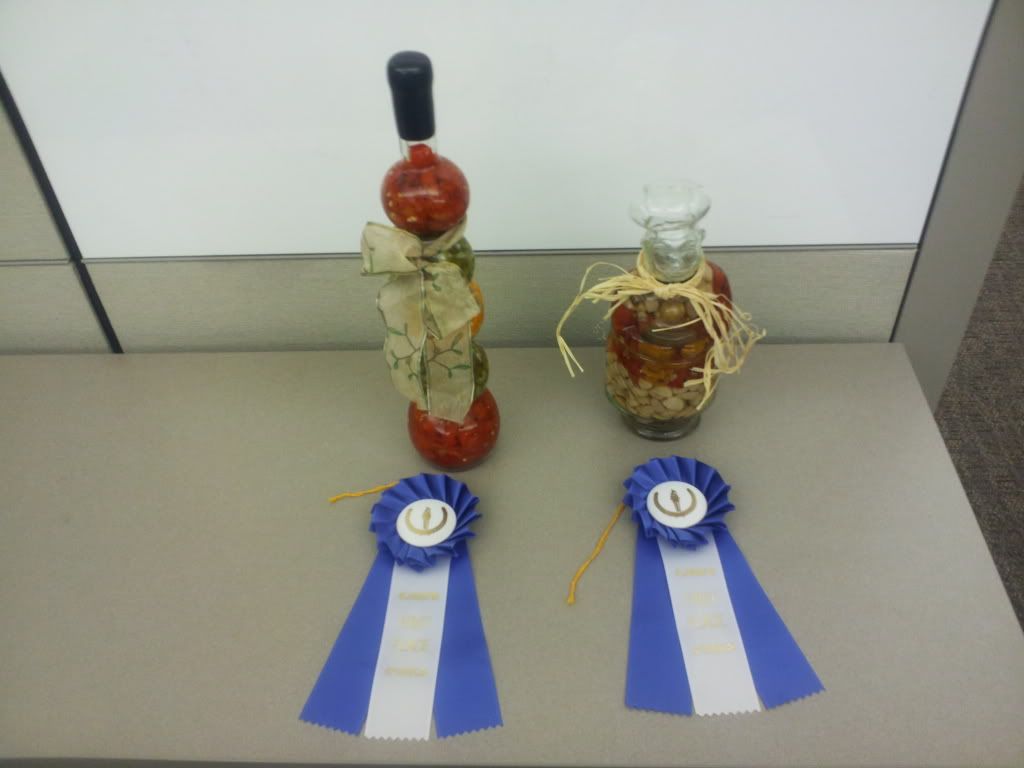The Annual Office Chili Cook-Off
Today was the annual chili and cornbread cook-off at work. I won first place in both, which was a bit of a surprise because I was using a new chili recipe this year. I've won second place in chili twice in the past, so decided I needed to make some changes if I ever wanted to get a blue ribbon. I not only made changes, I made a completely different recipe based on ideas I picked up from various Internet sites. Here's a photo of my trophies/ribbons, followed by my chili recipe (I'll post the cornbread recipe sometime in the near future):
Terry's
Award-Winning Beef Short Rib Chili
Ingredients
Black Peppercorns
2 Tablespoons Cumin
Seeds
1 ½ Teaspoons
Coriander Seeds
1 Star Anise
1 Tablespoon Coffee
Beans
Kosher Salt
8 Pounds Beef Short
Ribs, Bone-in
2 Tablespoons Peanut
Oil
3 Pasilla Chile Peppers (Dried
Chilacas)
2
Chile
de Arbol peppers,
Dried
2 Chipotle Chile
Peppers (Smoke-dried Jalapenos)
1 Quart Chicken
Stock
2 Anchovy Filets
2 Teaspoons Soy
Sauce
2 Tablespoons Tomato
Paste
1 Ounce Unsweeted
Chocolate
1 Yellow Onion
2 Shallots
4 Cloves Garlic
2 Fresh Jalapenos
1 Tablespoon Dried
Basil Leaves
1 Tablespoon Dried
Oregano Leaves
4 Bay Leaves
1 Pound Mexican
Chorizo Sausage
1 28-ounce Can
Crushed Tomatoes
¼ Cup Apple Cider
Vinegar
3 15-ounce Cans
Black Beans (plain, without sauce)
1 Envelope Sazon
Goya Seasoning
¼ Cup Vodka
4 Tablespoons Hot
Sauce (Preferably Frank's RedHot)
Ground Cayenne
Pepper
Grind the black
peppercorns using a coffee grinder and set aside.
Combine the cumin,
coriander, and star anise in a small frying pan or saute pan. Gently
toast the spices over medium heat until aromas are intensified and
color is slightly darkened. Do not allow the spices to smoke, or the
coriander seeds to pop. Once toasted, grind the spices together in
the coffee grinder and set aside.
Grind the coffee
beans in the coffee grinder and set aside.
Remove
the tops from the dried chiles (pasilla, arbol, chipotle), remove the
seeds, and cut them into rough 1” pieces. Toast the chiles in a
large, heavy pot or dutch oven over medium-high heat, stirring
frequently, until darkened but not burned. This will release the
intense aromas of the peppers. Once toasted, place them in a small
bowl and set aside.
If the short ribs
are Korean-cut (i.e. flanken style), separate them between the bones
using a sharp, heavy chef's knife. Trim excess fat and remove any
membranes/silverskin. Sprinkle the kosher salt and freshly-ground
pepper on all sides of the ribs. Heat up pot/dutch oven over a very
high flame, then add two tablespoons of peanut oil to the pan. When
the oil is rippling, shimmering, and smoking, add the ribs and brown
them well on all sides. They probably won't all fit at the same
time, so work in batches. As the ribs are removed from the pan,
place them in a roasting tray or on a large platter and allow them to
cool. Once all of the ribs are browned, pour off the remaining
oil/rendered fat into a bowl and set aside.
Turn the heat on the
pot down to medium-high and deglaze with 1 cup of the chicken broth.
Use a flat spoon or sturdy spatula to scrape up the browned bits
stuck to the bottom of the pot. Reduce heat to low and simmer. Add
the toasted, dried chiles to the broth and cook until they are
softened and the chicken stock is reduced by half.
Pour the
stock/pepper mixture into a blender or food processor. Add the
anchovies, soy sauce, and tomato paste. Add the gound coffee. Add
the ground cumin/coriander/star anise mixture. Chop the unsweetened
chocolate and add it. Blend on high speed until completely pureed
and smooth. Set aside.
Once ribs are cool
enough to handle, trim meat from the bones and cut into smallish (¼
to ½-inch) pieces. Reserve the bones for use later. Add any
accumulated juices from the roasting tray or platter to the pureed
chiles.
Dice the onion and
shallots. Mince the garlic. Trim the tops from the jalapeno
peppers, remove seeds, and mince. Pour the reserved oil from
browning the ribs into the pot. Add additional peanut oil if
necessary to make 4 Tablespoons. Turn heat to medium. When oil is
shimmering, add the onions and saute, stirring frequently, until they
are softened and translucent. Add shallots, garlic, jalapenos,
basil, and oregano. Continue to cook and stir until fragrant, about
1minute. Add pureed chile mixture and cook for a few more minutes,
stirring frequently and scraping the bottom of the pot until the
chile mixture begins to fry and leaves a coating on the bottom of the
pot. Add the remaining chicken stock, chopped rib meat, rib bones,
and bay leaves. Bring to a simmer, scraping the bottom of the pan to
loosen any brown bits. Reduce heat to the lowest possible setting
and cook, with the cover slightly ajar, for 1 hour.
While chili is
gently simmering, fry the chorizo sausage in a skillet or frying pan
over medium-high heat until crisped and slightly browned.
Add the chorizo,
crushed tomatoes, cider vinegar, beans, and Sazon Goya seasoning.
Continue to cook with the cover slightly ajar until beef is tender
and broth is rich and slightly thickened, about 2-4 hours. Add water
if necessary to keep beans and meat mostly submerged.
Using tongs or a
slotted spoon, remove and discard bay leaves and rib bones. Add
vodka and hot sauce, stirring to combine. Season to taste with salt,
pepper, and additional vinegar. For additional heat, add a small
amount of cayenne pepper, tasting frequently and adding gradually to
avoid making the chili too spicy.
Serve immediately,
or for best flavor, allow to cool and refrigerate overnight.



















































